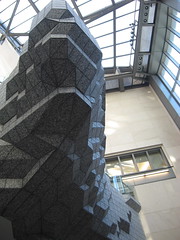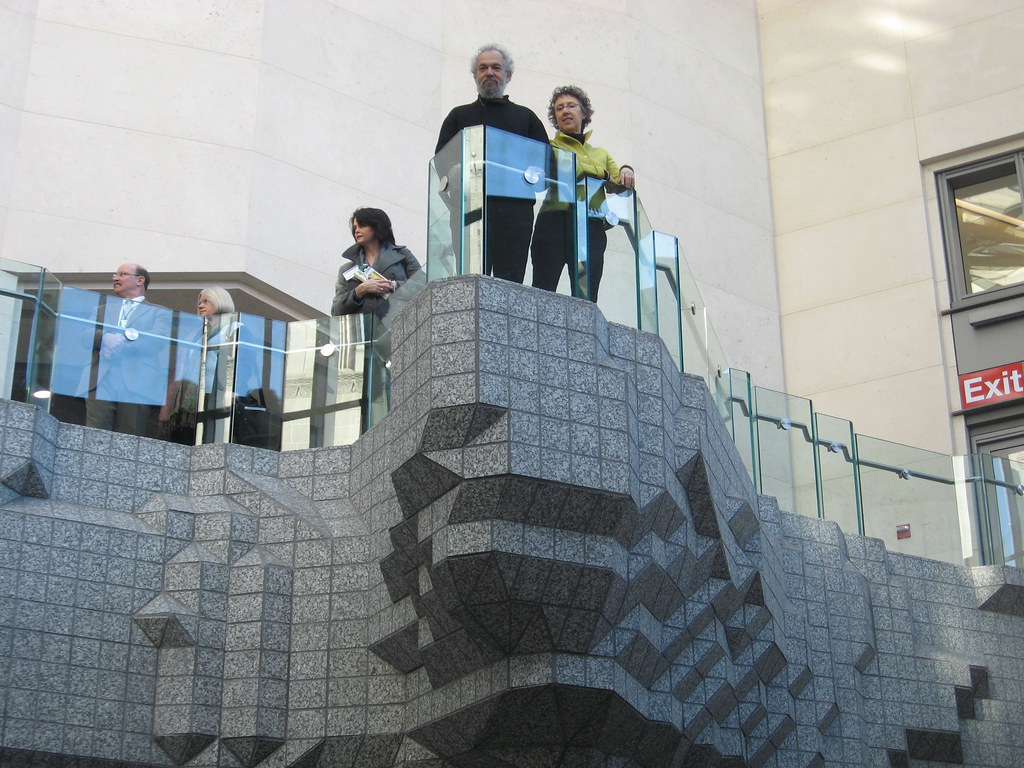At ground level at the new Atlantic Ave. Terminal, Allen and Ellen Wexler’s “Overlook” inspires an outdoor pause. (Photo by Benjamin Kabak.
Grand train terminals have long been prime people-watching areas. The buildings are alive with those who scurry to and from trains, those who are waiting for friends and loved ones to arrive, those counting down the minutes until they can head home and those simply enjoying a public space. Stepping back to observe the pace of life in motion is one of the pleasures of commuting life.
A few weeks ago, the MTA finally cut the ribbon on its new terminal building at Atlantic Ave. in Brooklyn. Over budget and past deadline, the new building garnered praise for its airy inside and state-of-the-art facilities. Inside the terminal, at ground level but overlooking the lower level is the MTA’s latest Arts for Transit installation, and it is evocative of that people-watching tradition of train terminals.]
Early last week, I took a tour of the building and spoke to the artists behind the “Overlook,” a granite-and-glass installation that brings a sense of calm and tranquility to an otherwise busy building. It is, in the words of Allen Wexler, half of the husband-and-wife team behind the piece, supposed to represent “the intersection between nature and city” in an urban environment.
The artists, pictured above, talked to me about their design process and the inspiration for the piece. The two of them worked closely with John di Domenico, the architect behind the new terminal building, to construct something that would seem both natural for the terminal but also unique for the space. It is a site-specific installation meant to evoke a scenic overlook at a national park, and it transforms the upper level into a spot for simply watching urban nature.
The Wexlers took images of national park overlooks and came up with a fractal computerized design. Each granite panel is connected to the others via straight lines to turn this into what the artists called “a pxilated iconic scenic overlook.”
“We sought to create the experience of viewing an urban public space as if it were a nature setting, using granite tiles mathematically pixilated to create nooks and crannies similar to those found in rock walls,” Allan Wexler said. “Our public work seeks to engage the people who use the space, creating a rich experience that resonates over time.”
 In the end, the MTA hopes that their new installation creates a meeting space at the station as well. With over 25,000 LIRR passengers and 31,000 subway travelers passing through the new terminal each day, the “Overlook” is ready to become a local landmark. “This vantage point was created as a collaborative effort combining our design that placed the wall between two sweeping stairways and the artists’ vision of morphing that structural wall into an outcropping of rocks,” di Domenico said.
In the end, the MTA hopes that their new installation creates a meeting space at the station as well. With over 25,000 LIRR passengers and 31,000 subway travelers passing through the new terminal each day, the “Overlook” is ready to become a local landmark. “This vantage point was created as a collaborative effort combining our design that placed the wall between two sweeping stairways and the artists’ vision of morphing that structural wall into an outcropping of rocks,” di Domenico said.
Hanging above the ticket area, the waiting room and two grand staircases, it’s bound to become the terminal’s prime people-watching spot as well.
After the jump, a slideshow of scenes from the new Atlantic Ave. Terminal. Click on any of the photos in the post to enlarge.



 First up, the G train. For the next four weekends, there is
First up, the G train. For the next four weekends, there is  Next up, the Rockaways. The first part of the Rockaways rehab project was supposed to start wrapping up this week. But delays! The Far Rockaway-bound A platforms at Beach 67th and Beach 44th Streets are scheduled to reopen as planned on Monday, January 18, 2010, but the Manhattan-bound platforms at Beach 105th and Beach 90th Sts. and the Far Rockaway-bound platform at Beach 25th St. won’t open until Monday, January 25.
Next up, the Rockaways. The first part of the Rockaways rehab project was supposed to start wrapping up this week. But delays! The Far Rockaway-bound A platforms at Beach 67th and Beach 44th Streets are scheduled to reopen as planned on Monday, January 18, 2010, but the Manhattan-bound platforms at Beach 105th and Beach 90th Sts. and the Far Rockaway-bound platform at Beach 25th St. won’t open until Monday, January 25.  Finally, the Brighton Line. This work affects the Q as well. Anyway, on Monday at 5 a.m., the Brighton Beach/Coney Island-bound platforms at Ave. U and Neck Road will reopen. The Manhattan-bound platforms will close for a year. Trains will continue to bypass Aves. H and M until the Fall, and all Brighton Beach-bound B trains will make all local stops.
Finally, the Brighton Line. This work affects the Q as well. Anyway, on Monday at 5 a.m., the Brighton Beach/Coney Island-bound platforms at Ave. U and Neck Road will reopen. The Manhattan-bound platforms will close for a year. Trains will continue to bypass Aves. H and M until the Fall, and all Brighton Beach-bound B trains will make all local stops. 
 One hundred and three days ago, Jay Walder assumed control of the Metropolitan Transportation Authority. As an incoming CEO and Chairman with a career’s worth of experience in transit, Walder set about to figure out a way to improve the MTA. As he worked to figure out how to streamline the MTA and improve services, the authority ran headlong into budget problems, and his review shifted to focus on cost cutting measures and efficient spending.
One hundred and three days ago, Jay Walder assumed control of the Metropolitan Transportation Authority. As an incoming CEO and Chairman with a career’s worth of experience in transit, Walder set about to figure out a way to improve the MTA. As he worked to figure out how to streamline the MTA and improve services, the authority ran headlong into budget problems, and his review shifted to focus on cost cutting measures and efficient spending.  Thomas DiNapoli, the New York State Comptroller, issued a brief report on the state of the MTA ridership levels yesterday. The report is written in a way to draw headlines. “Ridership declines cost MTA $100 million,”
Thomas DiNapoli, the New York State Comptroller, issued a brief report on the state of the MTA ridership levels yesterday. The report is written in a way to draw headlines. “Ridership declines cost MTA $100 million,”  Phase I of the Second Ave. Subway is one expensive project. Designed as a three-mile extension of the BMT Broadway line north from 57th St. and 7th Ave. to 96th St. and 2nd Ave., this route is, as SAS commenter Alon Levy
Phase I of the Second Ave. Subway is one expensive project. Designed as a three-mile extension of the BMT Broadway line north from 57th St. and 7th Ave. to 96th St. and 2nd Ave., this route is, as SAS commenter Alon Levy 
